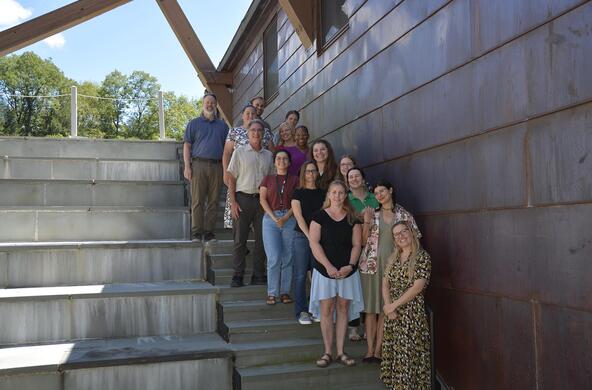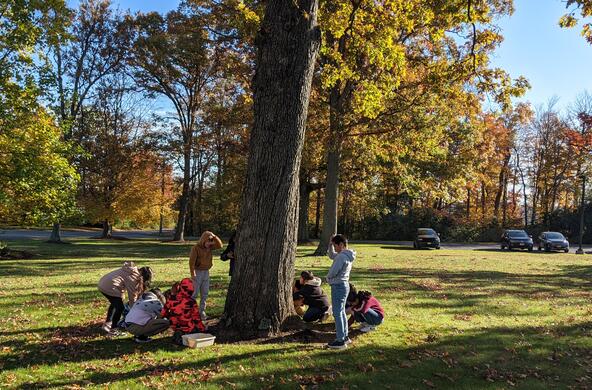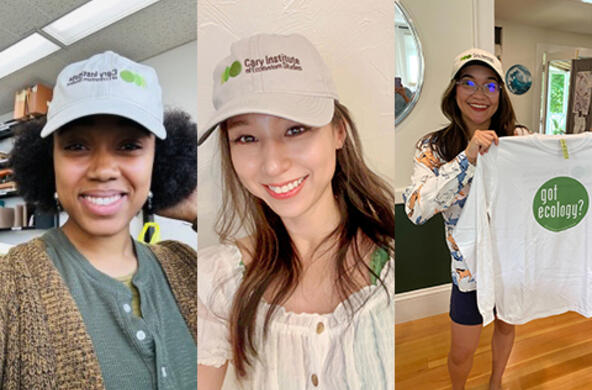A class of second-graders at St. Joseph School, Millbrook, gathers around a study plot in the grass of their schoolyard, marked by four pink flags in the shape of a square. Over the next few months, under the guidance of educators from the Cary Institute of Ecosystem Studies, these students will act as scientists, observing the growth of plants and documenting the timing of the first leaves and flowers on each species.
These students are part of a larger citizen science project — called Project BudBurst — that is examining the phenology, or timing of natural phenomena, of flowering plants across the United States.
When one student asks, "When do we get to plant the seeds so we can watch our plants grow?" it is evident that some students do not understand that plants can grow independent of human cultivation. This spring, as students observe their study plots, they will witness first-hand that many plants grow where wind, animals and other dispersal agents have transported the seeds. By comparing plots in different parts of the schoolyard, they'll also learn how local environmental conditions influence plant growth.
When science is something they do rather than something they read about in a textbook, students stop looking to their teachers for all the answers and begin the journey of finding answers for themselves. This method of teaching, referred to as "inquiry-based science" in the field of education, builds critical-thinking skills as students learn about the world around them.
When students form hypotheses and collect data on the timing of plant growth, they learn more than the basics of the life cycles of plants. Through the systematic observation of their plots, they also consider how warmer temperatures in one plot may lead to earlier flowering than plots in the shade of the school building. They consider the effects of global climate change on plant growth around the world, and how those changes affect ecosystems.
In our increasingly complex global community, with daily advances in science and technology, it is important to get youth involved in science as early as possible. As adults, they will be called upon to make many important decisions that require, at the very least, a basic understanding of science. Ensuring that our young people can understand current science topics such as nanotechnology, stem-cell research, and global climate change in light of a reported 33 percent reduction in science instruction in our nation's schools is no simple task.
To reconnect our nation's students with science, President Barack Obama initiated an "Educate to Innovate" Campaign for Excellence in Science, Technology, Engineering and Math. This initiative recognizes the importance of scientific literacy and calls for universities, nonprofit groups and scientists to work with educators.
The Cary Institute understands what is at the heart of this initiative: that partnerships formed between scientists and educators enrich the learning process for students by marrying expert knowledge from scientists with the teaching skills of educators. While our scientists are increasing their knowledge of ecology, our staff educators are working with teachers to make the findings available to students and to help them create their own field studies.
The Cary Institute's education program strives to create unique experiences for K-16 students and teachers, such as the phenology science project conducted by St. Joseph's second-graders. We engage students in locally relevant ecological topics ranging from the impacts of invasive species on the Hudson River to the effects of climate change on the prevalence of Lyme disease.
Our students do "bio-blitzes," recording as many species of plants and animals as they can find in their schoolyards, or build small-scale greenhouses to observe the effect of rising carbon dioxide on air temperature. We encourage teachers to take their students to the local drinking water and wastewater treatment plants so students understand how they are connected to the waters that flow through lakes and rivers.
In a time when human actions are resulting in unprecedented changes in the Earth's ecosystems, engaging young people in environmental science is paramount.






